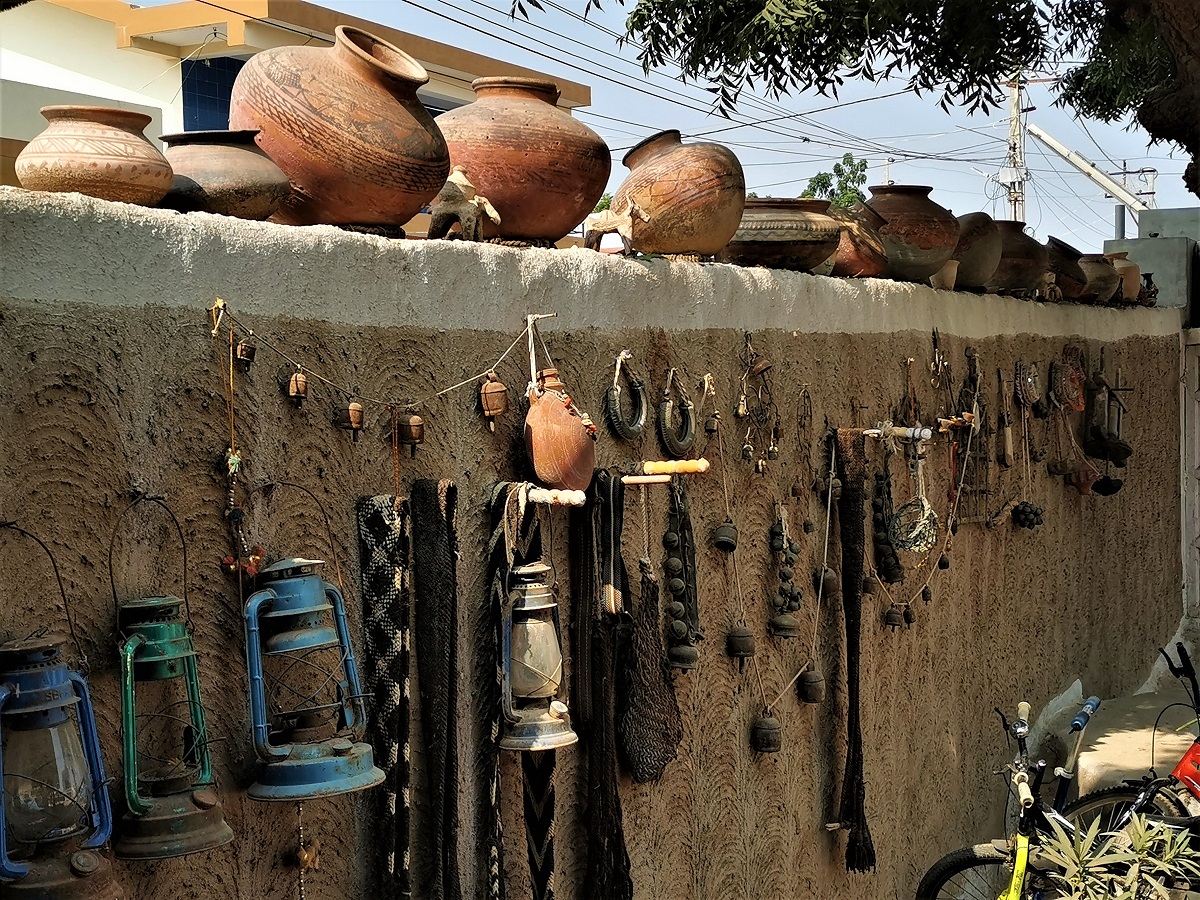The Ranns, deserts, artisan villages, stepwells of Gujarat, and much more… in 9 stories… this is ‘story 4’


Co-authored & edited by my travel companion – Shoba Nayar

Driving to Bhuj: Exploring Along the Way

The following morning, we set off from Bajana towards the city of Bhuj in the heart of the Great Rann. The countryside contained more cotton and castor oil fields interspersed among the scrubby wasteland and large factory buildings in this industrial state of Gujarat. Along the way we encountered herds of goats, and camel trains leaving for the seasonal sweet grass in other States whilst some nomadic travellers and animals were still in their camps. The sun was rising and the day was getting hot— ‘maybe they were not moving camp today’ I thought.


The Salt pans of Gujarat
We crossed the salt plains (pans). Once the high tidal season fills these plains, the familes of salt workers create walls of mud and salt to contain the water until it all evaporates leaving only the salt to be harvested.

It is hard work and takes its toll on the families, young and old. There are seveal articles on the internet about the life and hardships of these workers. One such article is:

Meeting Ajay and visiting the artisan weavers of Bujodi
Arriving on the outskirts of the city of Bhuj, we met our new guide Ajay, and began by visiting the artisan weavers of Bujodi.

We saw how they ‘card’ the sheep’s wool, spin the raw cotton, dye the yarn in natural dye such as indigo, and weave it on the hand looms into the most beautiful shawls, wraps, and bolts of cloth using traditional designs.



Shopping!
In the shop we had a lot of fun choosing purchases of gifts for ourselves and others before having lunch with some of the family. Today was a very special day as they excitedly awaited the arrival home of the youngest son who had married two weeks before and was bringing his new bride home for the first time.



A tribal family business
The 35 year old son who showed us the process of the family’s life works, has a Masters degree in Art History. As we talked about their proud family heritage of making beautiful and quality textiles, he also talked to us as about life in their tribe and marriage within the community—what makes it work or not work, such as particular customs within the household and how these are handed down through the generations. These customs and ways vary from tribe to tribe and it can be difficult for a young couple to settle into this life if they have tasted the life of the big cities and are not from the same area. This was not just a visit to an aritsan shop but an interaction with the people of the land and we felt privileged to have had the time to chat about not just the production line and cloth, but life as they experience it – very different from our own.





In the compound where the weaving occurs





An introduction to Bhuj, the earthquake that put it on the map and an amazing museum visit
Leaving the village, we headed on into Bhuj with Ajay telling us stories of the 2001, 7.2-7.7 magnitude earthquake and the inestimable damage to the region. It is thought that as many as 20,000 people died and more than 150,000 were injured. Over 340,000 buildings were damaged or destroyed. One of our later guides told us that many people in India did not even know the region of the Great Rann was populated, let alone populated with the thousands of villagers who have recovered, rebuilt, and raised themselves out of the calamity to provide artisan trade using their thousands of years old skills and knowledge to become a tourist mecca for those intrested in art, craft, and cultural history.

Visiting the amazing museum in Bhuj
We first visited the museum founded in 1877, filled with fascinating artifacts, coins, and textiles some of which are hundreds of years old. A whole section of the museum has been devoted to tribal culture, folk art and craft, embroidery, paintings, musical instruments, arms of combat, sculptures, and metalwork.



Anicent pillars & hieroglyphics
There are broken and damaged pillars inscribed with hieroglyphics, many of which have never been deciphered because they are written in extinct Kutchi script. The oldest are said to be Kshatrapa inscriptions dating back to the 1st century AD.




An introduction to the Great Rann of Kutch & the tribal villagers
This area sits on the edge of where the mighty Indus River plain meets the Indian Ocean, a point that has changed over the centuries due to other major earthquakes such as the 1819 earthquake which shifted the course of the river to the west. The historical settlements along the Indus have kept many of their secrets; however, much of the arts and crafts which travelled with its people from Persia and areas further to the west are still in use today. We looked forward to exploring the Great White Desert over the following days, visiting the artisans, the villages, and the ‘Great Rann of Kutch’. The traditions and history seen in the museum represent the way of life still used for a major part of Kutch’s population. The cultural identity of the tribal villagers is fully supported today both economically and politically. This has been preserved as a living working force that we felt very fortunate and privileged to have been given the opportunity to experience on this journey.


A short visit to the Sun Temple Stepwell of Bhuj
Before leaving the city we visited a small but important ancient Sun Temple stepwell within walking distance of the museum. Not much is known about its history, and it is not known how much damage the successive earthquakes have caused making change to how it looks now to what it might have been in its glory days.


Private collections of local artisan works
After drinking delicious tea at a local shop we visited the home of a private collector of ‘stitched art’, rugs, wall hangings, door and window decorations, dowry bags, jewellery bags, and items made by local artisans and international craftspeople of this form of work. According to the owner, a learned man who developed his passion over the years before and after retirement, buyers from all around the world seek him out to provide what they want for their homes and collections.


Dusk was falling on this fascinating day
We left Buhj and drove out towards the White desert to our accommodation for the next few days – The Kutch Safari Lodge. Tomorrow, our adventure continues…
Story 5… ‘Exploring the Great Rann of Kutch – Day 1’… coming soon.
Travel organised with Suresh Bahuguna at Lotus India Journeys!
http://lotusindiajourneys.com/index.php
#rannofkutch #kutch #kutchdiaries #gujarattourism #gujarat #instagram #india #kutchi #kuchtourism #travel #incredibleindia #ourkutch #traveltheworld #worldtraveller #worldtraveler #lettheadventurebegin #teresaglobaltraveller #photooftheday #followme #toptags #nature #photooftheday #sun #naturebrilliance #picture #travel #lovemyphotos #india #naturephotography #nature_lovers #photography #photogram #theoutdoorfolk #teresaglobaltravels #traveltheworld #travelindia #travelgujarat #teresatraveller #bhuj #bhujkutch


Nice photos, nice story, which open my eyes! I think probably keeping the ancient lifestyle and artefacts is to remind modern people that wisdom is always wisdom in any times so that they have no grounds for complacency when facing it.
Thankyou ChiChi, and you have the wisdom to see it.. May, someday, you get to visit some of these beautiful places also!!! thankyou again